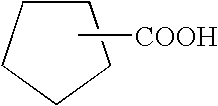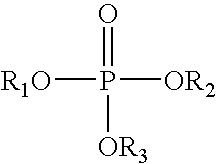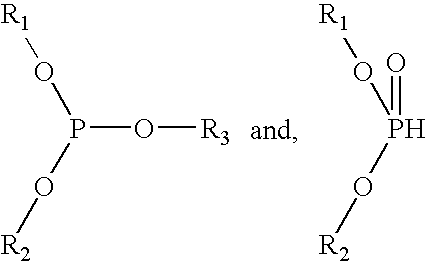Naphthenic acid corrosion inhibition using new synergetic combination of phosphorus compounds
a phosphorus compound and phosphorus compound technology, applied in the direction of corrosion inhibition of other chemical processes, distillation, separation processes, etc., can solve the problems of corroding equipment used to distill, damage to pipes and other associated equipment, and severe corrosion problems, and achieve the effect of low acid valu
- Summary
- Abstract
- Description
- Claims
- Application Information
AI Technical Summary
Benefits of technology
Problems solved by technology
Method used
Image
Examples
example 1
[0081]The weighed quantities of 68.16 gm of commercially available HRPIB (High Reactive Polyisobutylene with molecular weight 950 approximately), 30.31 gm of Phosphorus Pentasulphide and 1.51 gm of Sulphur Powder are charged into a clean four necked round bottom flask, equipped with N2 inlet, stirrer and thermometer, thereby forming a reaction mixture. This gives 1:1 mole ratio of Phosphorus Pentasulphide to Olefin.
[0082]The reaction mixture was stirred and heated to 160° C. temperature under nitrogen gas purging. The purging of N2 gas led to removal of hydrogen sulphide gas, which was generated during the reaction. The temperature of the reaction mixture was maintained between 160° C. to 180° C., for a period of 1 hour to 2 hours. Then the temperature of the mixture was raised to 220° C. and the mixture was maintained at this temperature for 6 to 10 hours.
[0083]The resultant reaction mass was then cooled to 100° C. when nitrogen gas was purged into it, to drive out the hydrogen sul...
example 2
High Temperature Naphthenic Acid Corrosion Test
[0085]In this example, various amounts of a 50% formulation of the composition prepared in accordance, with Example 1, were tested for corrosion inhibition efficiency on steel coupons in hot oil containing naphthenic acid. A weight loss coupon, immersion test was used to evaluate the invention compound for its effectiveness in inhibition of naphthenic acid corrosion at 290° C. temperature. Different dosage such as 300, 400 and 600 ppm of invention compound were used, as 50% active solution.
[0086]A corrosion inhibition test on steel coupon was conducted without using any additive. This test provided a blank test reading.
[0087]The reaction apparatus consisted of a one-litre four necked round bottom flask equipped with water condenser, N2 purger tube, thermometer pocket with thermometer and stirrer rod. 600 gm (about 750 ml) paraffin hydrocarbon oil (D-130) was taken in the flask. N2 gas purging was started with flow rate of 100 cc / minute ...
example 3
[0094]Experiments were carried out by the inventor of the present invention, to test the effectiveness of a commercially available phosphorus compound B, such as tributyl phosphate, in inhibition of naphthenic acid corrosion. Different dosages of tributyl phosphate, such as 75, 90 and 100 ppm were used in the experiments. The result of some of these experiments are presented in Table 5.
PUM
| Property | Measurement | Unit |
|---|---|---|
| temperature | aaaaa | aaaaa |
| temperature | aaaaa | aaaaa |
| temperature | aaaaa | aaaaa |
Abstract
Description
Claims
Application Information
 Login to View More
Login to View More - R&D
- Intellectual Property
- Life Sciences
- Materials
- Tech Scout
- Unparalleled Data Quality
- Higher Quality Content
- 60% Fewer Hallucinations
Browse by: Latest US Patents, China's latest patents, Technical Efficacy Thesaurus, Application Domain, Technology Topic, Popular Technical Reports.
© 2025 PatSnap. All rights reserved.Legal|Privacy policy|Modern Slavery Act Transparency Statement|Sitemap|About US| Contact US: help@patsnap.com



